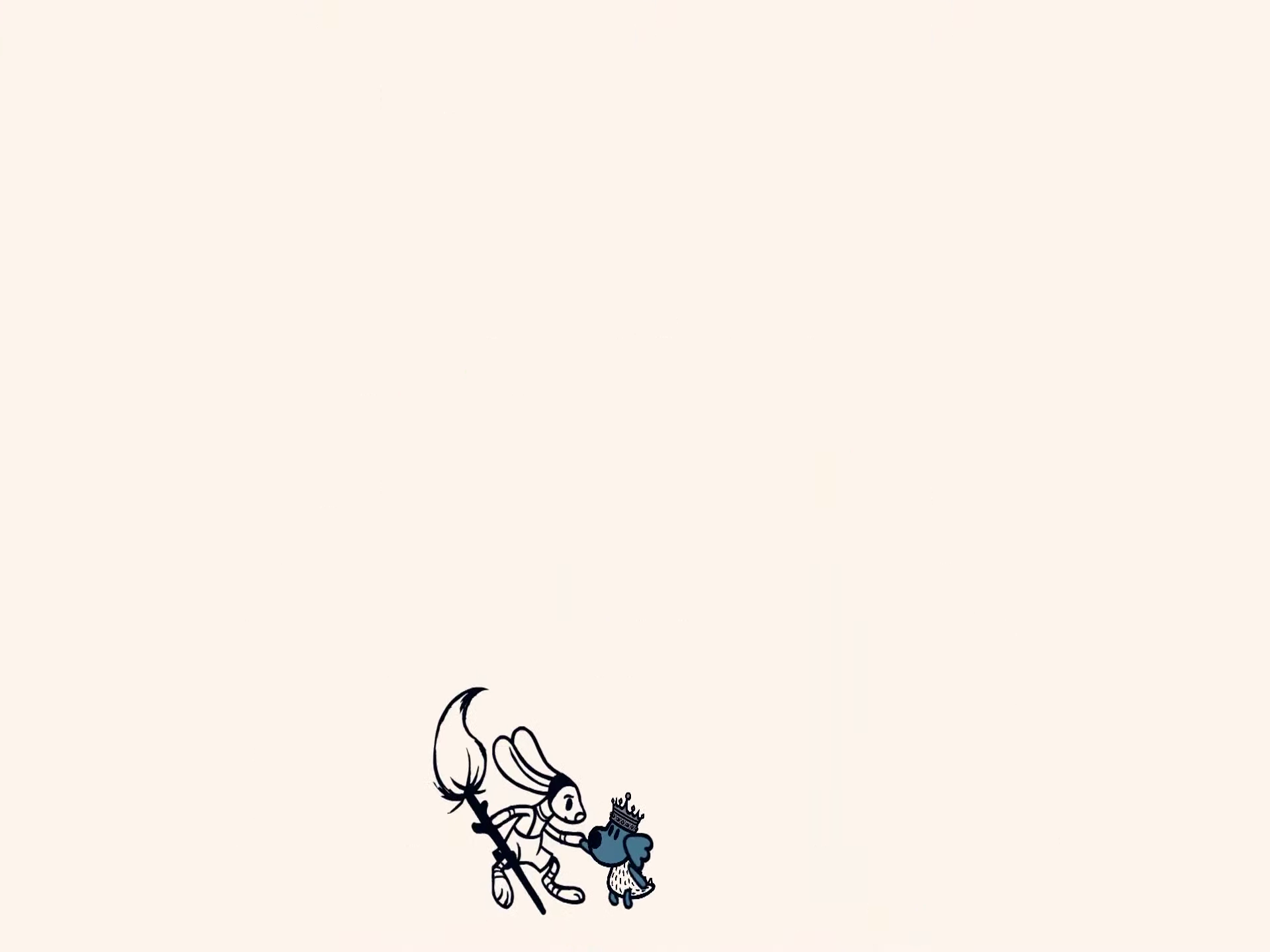
In Chicory: A Colorful Tale (A Colorful Tale for the rest of this, to help me distinguish the game from the character of Chicory), you play as (canonically named, anyway) Pizza: a janitor who becomes a Wielder of the Brush. The Brush is a magic paintbrush that literally brings color to the world. A Colorful Tale comes from a legacy of casual creators: tools, games, and interactive experiences that help a player express themselves creatively for the sheer joy of it. Being creative is its own reward in Kid Pix. Kids like to draw shit. Maybe once upon a time, we all liked to draw shit before we told ourselves some kinds of drawing were good, other kinds were bad, and for most of us, our drawings were bad.
A Colorful Tale is about making color and takes that compound verb and runs with it. You can color in the environments, props and cast. NPCs will ask you to burst out some creativity to tag a wall, or paint a sky. Certain NPCs recognize your art too, and are mostly approving. Pea will comment about the color density of any particular screen: she prefers a lot of different colors, which she recognizes as “details”. Certain NPCs will go to places you’ve colored and remark on it-- you can even get fan art from Peppermint. It’s delightful and relaxing to paint in A Colorful Tale: at least two hours of my runtime was just coloring in Dinners because life was tough that week.
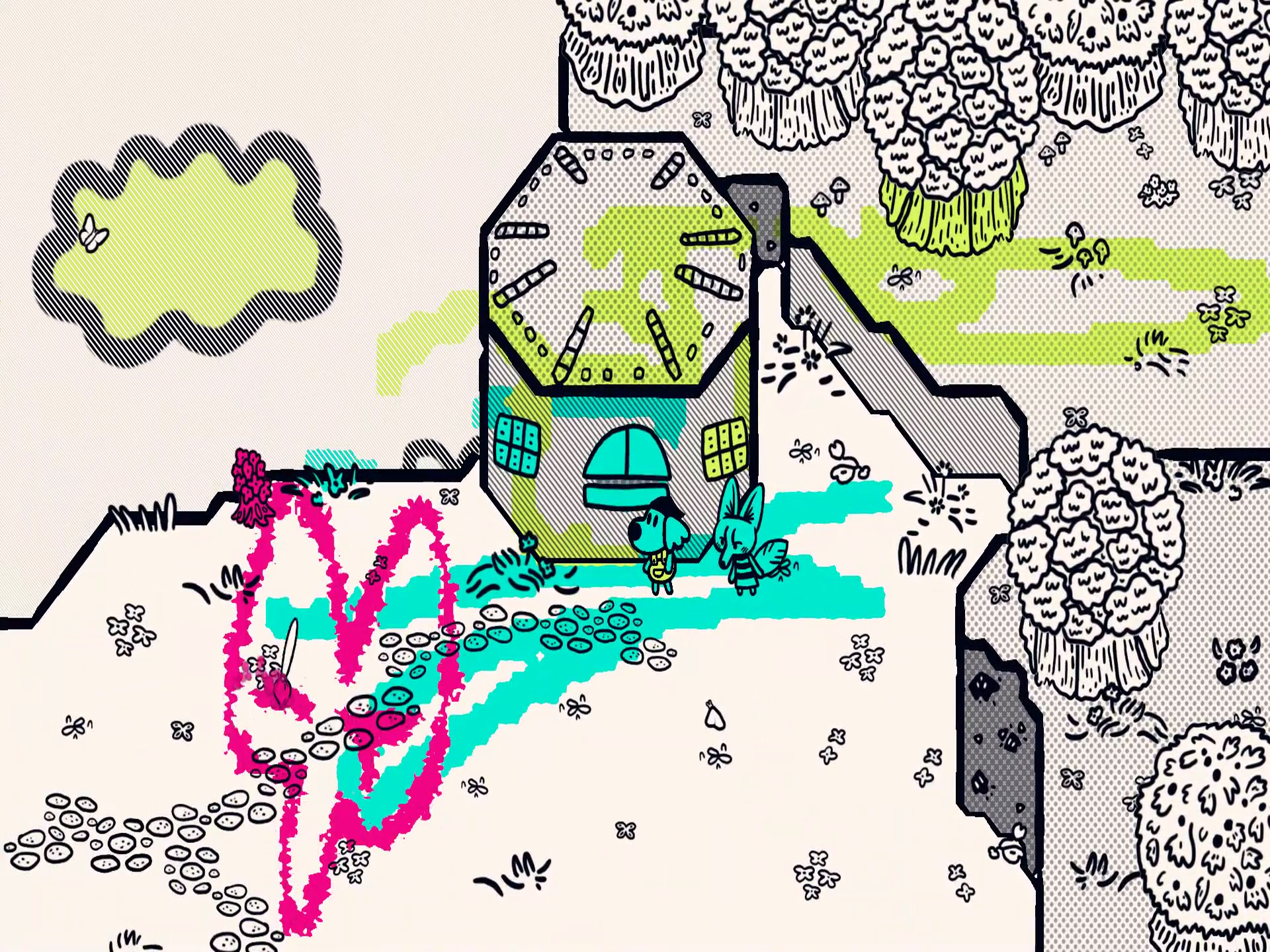
The game is seeped in that childlike sense of making color: a recorder is used as the principal instrument for the protagonist. If you were a certain kind of child, you had to get a recorder to make a sound for a grade in school. By that point in my life, I knew the sound was bad-- plastic’s a tough resonator. The recorder in my memory has a harsh, piercing sound, especially when paired with my beginner’s embrasure and breath control.
I played A Colorful Tale using a game pad because I confused it with Get in the Car, Loser! I started both games around the same time and for some reason, conflated GITCL’s recommendation to be played on a game pad with this one. This is important because all the puzzles are still solvable on a pad, but drawing is really goddamn hard with two sticks. And, unfortunately there are the times when you need to make Art, not just make color.
Capital A art. Art within a system that places expectations on those who engage with it. Art for other people that needs to make them feel things, draw customers, or move product. The times when the game gives you a blank canvas, two sticks of insufficient precision, some 4 color palettes, whatever brush styles you’ve picked up and an abstract demand are the hardest parts of A Colorful Tale. Old wielder Cardamom has it completely right: making color when you don’t want to, for other people, is tough.
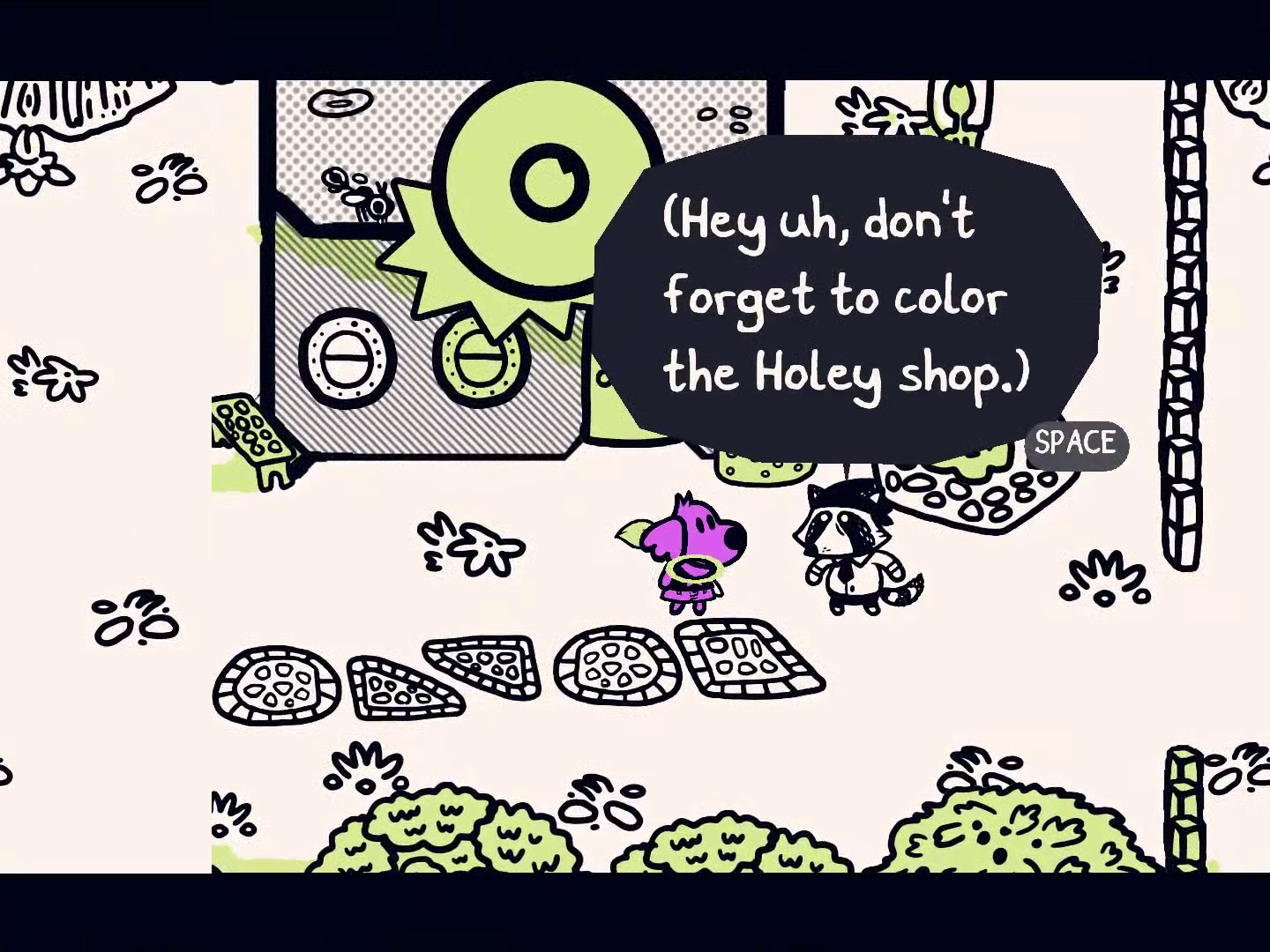
The game reminds you that you can always say No to these requests (Pizza’s sister Clementine has a touching scene in a, uh, pizza shop about it), but to my ear, the dialogue suggested that past wielders of the Brush never said No. People expect you to. But, I only had two sticks of insufficient precision and a palette of four colors: I never felt good about my art in comparison to the past Wielders, and couldn’t shake that I had let them down, somehow.
This is at its clearest when you get to see art from your hero, Chicory, and compare it to your kindergarten grade finger paint. The portrait Pizza gets from Chicory in the first third of the game is miles better than anything you can possibly draw. Your tools are lacking: all your art always looks chonky and blocky due even the thinnest brushes being thick, shading is impossible, forget value, even blocking out colors is tricky with the limited palette.
Chicory can say whatever she wants after you exchange canvases, the damage is already done. I could feel my soul drop after trying really hard on her portrait and realizing she gave me something beautiful, far beyond anything I could ever make, in reply. An equal gift exchange this was not. Maybe she shouldn’t have given me the Brush after all. Maybe that angry student at the Art School was right.
It’s a brilliant bit of design: having you enact an exchange meant to make you realize your creative output is completely outclassed. It feels bad. It’s a horrible feeling, shame like dark roots grips your impulse to make more color and strangles it. Exactly like the black roots of corruption that are strangling the wilderness of Picnic.
And it’s Chicory’s fault, both times.
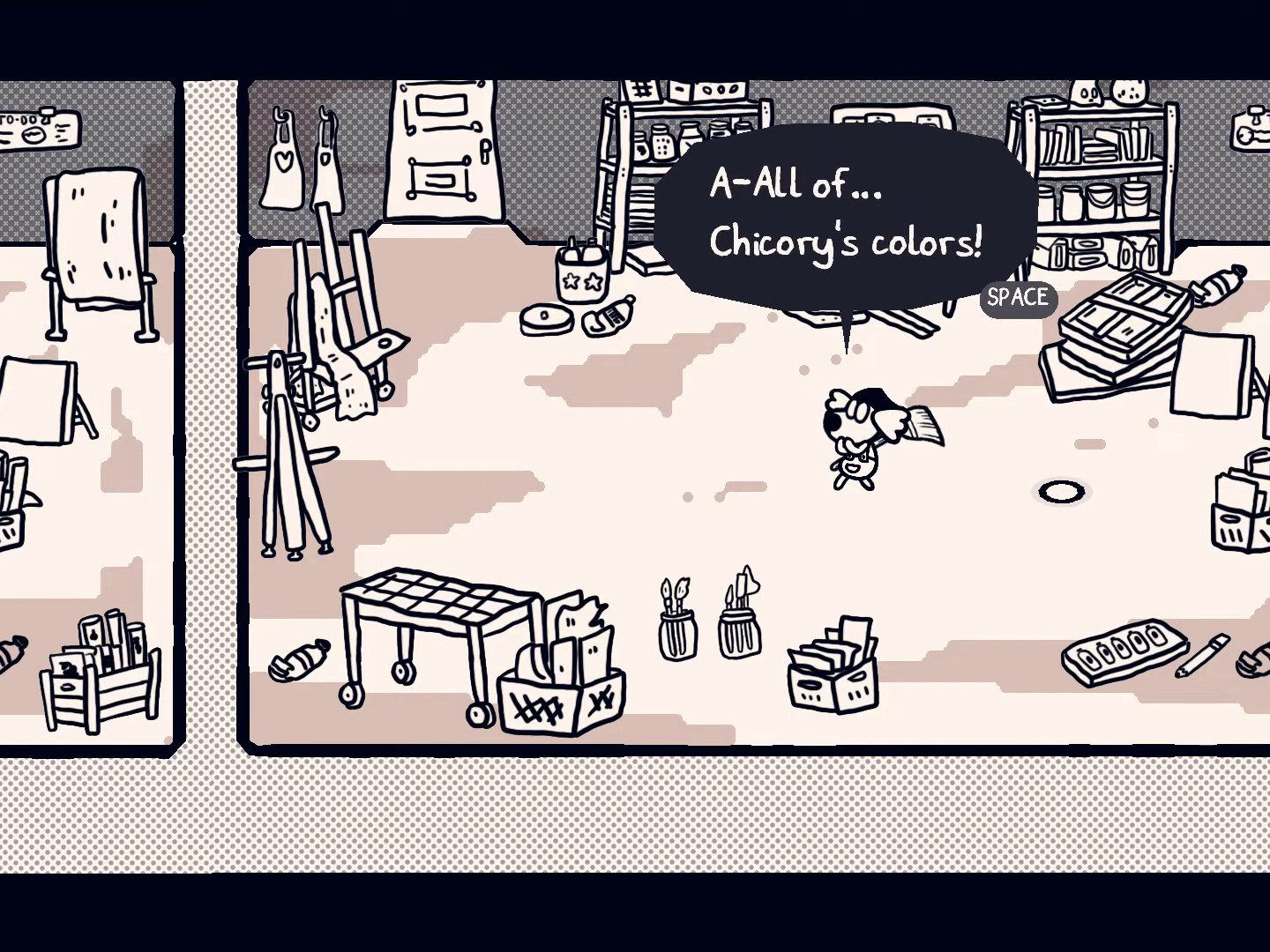
I couldn’t quite figure out how, exactly, Picnic lost its colors. Chicory may have erased all the colors in a perfectionist fit before throwing the Brush down and locking herself in her room. The color may have evaporated as corruptions from the Brush raged unchecked across Picnic first, causing Chicory to give up and collapse into a deep depression. It doesn’t really matter.
Chicory’s tenure as wielder is fraught-- the stress she takes on isolates her from everyone else. Blackberry, her mentor, pushed her to the brink to earn the Brush. When she tried to connect with Chicory to pull her back, the student snapped. The Brush lets its wielders color the world, but also manifests their worst selves as corruption. For all the good Chicory did, her unsteady-at-best mental state caused the brush to manifest the strongest, worst corruptions anyone had ever seen.
And it breaks her. Completely. Chicory starts the action of the game AWOL as color is ripped from the world. When Pizza can finally reach her in her room to give the brush back on Blackberry’s orders, she’s barely verbal. Her room is a wreck. She’s a wreck. She passes on the brush without a second thought, with no instruction or aid or help. As the corruptions get worse, she recovers, overjoyed to just get rid of the damn thing. She does the awful art swap, extremely unaware of just how much it stings.
And as the Brush (still having all of the nastiness that Chicory is capable of saved up) reveals to Pizza: for part of the bunny, this is exactly what she wants. Her untrained and unprepared janitor has the Brush, and she’s ready to just whistle off to the sunset and take no responsibility. It’s Pizza’s problem now. Pizza’ll clean up this mess, just fine. Just like Pizza has cleaned up all the other messes.
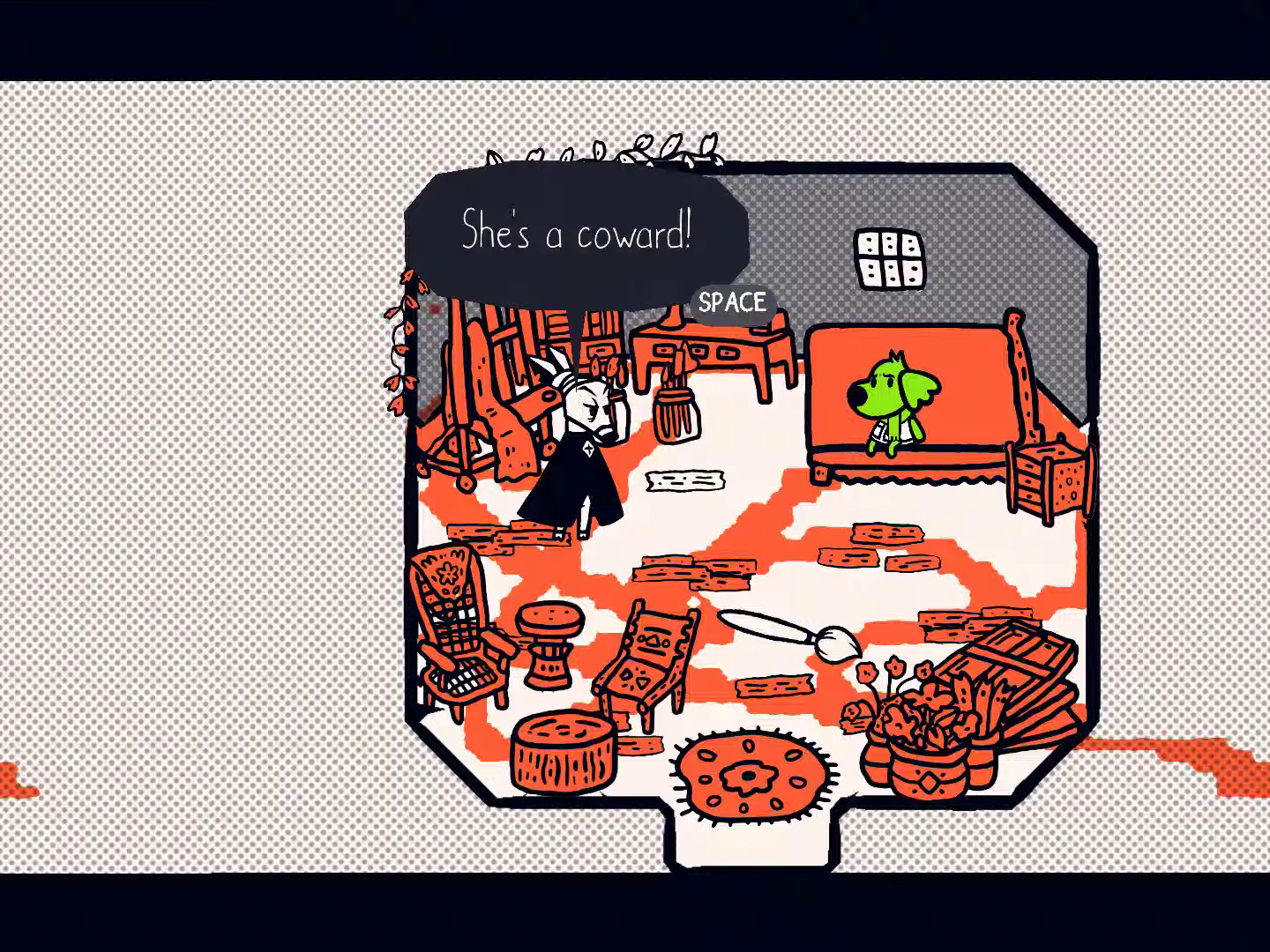
Until Pizza confronts her about it. So, Chicory locks herself in her room again. Until Pizza confronts her again, because the old way of cleaning up these corruptions isn't working. Chicory needs to step up. Pizza can’t do it on their own.
And she still can’t rise up to it.
Chicory panics and lashes out, drawing upon the corruption. The game explicitly calls the sequence leading up to this boss fight a panic attack in its content warnings. Blackberry, despite being an asshole, is right: Chicory can’t handle the pressure or responsibility. Where that fault lies-- in the system around the Wielders, Chicory herself or the Brush itself is irrelevant. There is a problem, Chicory has the training to deal with it, and she doesn’t.
Pizza, because we all worship our heroes, gives Chicory a fifth chance, and Chicory finally takes a step forward: she’s willing to lead Pizza through the wielder trials Pizza should have gone through before getting the Brush. This will build Pizza’s bond to the brush and give them a chance at fighting the big corruption fueling all the others.
But, you know where this is going.
Chicory’s teaching style is extremely hands off. The rabbit points Pizza to a zone, hops to a midpoint, and waits for our poor beleaguered dog. They have a heart to heart, and then Chicory hops away. She isn’t in the shit with you, solving puzzles or fighting bosses. The chats the pair has are focused on Pizza: Chicory usually prompts Pizza to reflect on being a Wielder. It’s in these long sections of dialogue Pizza starts to verbalize and externalize their own darkness. They put words to the feelings of inadequacy that Chicory herself has helped ferment. These are good chats! But Pizza doesn’t need a therapist, they need material help.
I’ve been hard on the painterly bunny, so I want to make something clear: I love Chicory. I used her for a long while as my profile picture on Discord. Chicory’s repeated failure to set aside her internal anguish and rise above it is why I love her. She knows she’s failing Pizza as a mentor. She talks about it. She can see how her flaws have mixed with a culture and system that hurts its heroes. She, more than the entire rest of the cast, can see how she’s fucking up. I loved her back when we first saw her when she’s barely verbal on the bed. I love her here, as she’s a terrible teacher. She’s smart enough to see the systemic cracks, brazen enough to be ready to burn the system to the ground, but not bold enough to do it or strong enough to build the scaffold of something to take its place.
During one of the Wielder trials, the source of Chicory’s anguish comes to light. Her and Blackberry broke bad when Blackberry started to poke at Chicory’s crumbling mental state, back when Chicory was an apprentice. Chicory, in a move that should surprise no one, can’t face it and sends Pizza to clean up the corruption rooted in this painful memory. I love you, you cowardly, self-centered bunny. Your flaws make you whole.
Pizza faces the source of corruption at the top of the Wielder tower, but even after passing the Wielder trials, they fail. Their inability to admit their fear (I have to be perfect for Chicory!) and Chicory’s inability to deal with her own shit (I can’t do this, I’ll send in Pizza) cause the Brush to be lost. Pizza feels like Chicory’s mentorship hasn’t helped (because it hasn’t); Pizza doesn't feel ready and doesn't want to admit it. The Brush strikes at this chink and wins.
A Colorful Tale pulls the same hat trick nearly all games do when they’re good: solutions are much, much harder than problems. This cute video game isn’t the place to try and champion what it’ll take to build a new system that supports its Wielders. Too much real life is tied up in that-- solutions out here are messy, complex, and oft-times painful. The game takes a well-earned shortcut. Brushless, Pizza and Chicory reunite at the base of the Wielder’s Tower. Luncheon is covered in darkness. Everyone has left. The monument to the Wielder’s failures is staring them in the face. They embrace. It feels like the first true hug they’ve given each other-- the first time they’ve met as equals. They know.
Chicory finally gives Pizza an answer to the question that has been hounding the dog the entire game:
Pizza: Back when you first gave me the Brush...
Pizza: Did... you REALLY think it was a good idea?
Pizza: Did you really "choose" me?Chicory: No.
Chicory: I just wanted to be free of itPizza: Did you "choose" me BECAUSE I was a bad choice?
Pizza: Is that all I mean to you?Chicory: When I said you could take the brush...
Chicory: You had already taken it, and colored...
Chicory: And faced a corruption, and made it back.
Chicory: You already proved it yourself, a million times.
This gives Pizza the insight and courage the poor dog needs-- along with Chicory’s reframing around who can be An Artist-- to grow a new brush tree and make a brush, out of whole cloth. Armed, Pizza goes back in. Chicory has sent her janitor to clean her messes countless times before, and isn’t about to stop.
You start the boss fight, but the new brush is just a brush. It doesn’t give you any new special powers. The boss just pulls the same shit as before, trapping you in a mess of corruption. Despite everything, you’re still you.
Except, finally, Chicory shows up.
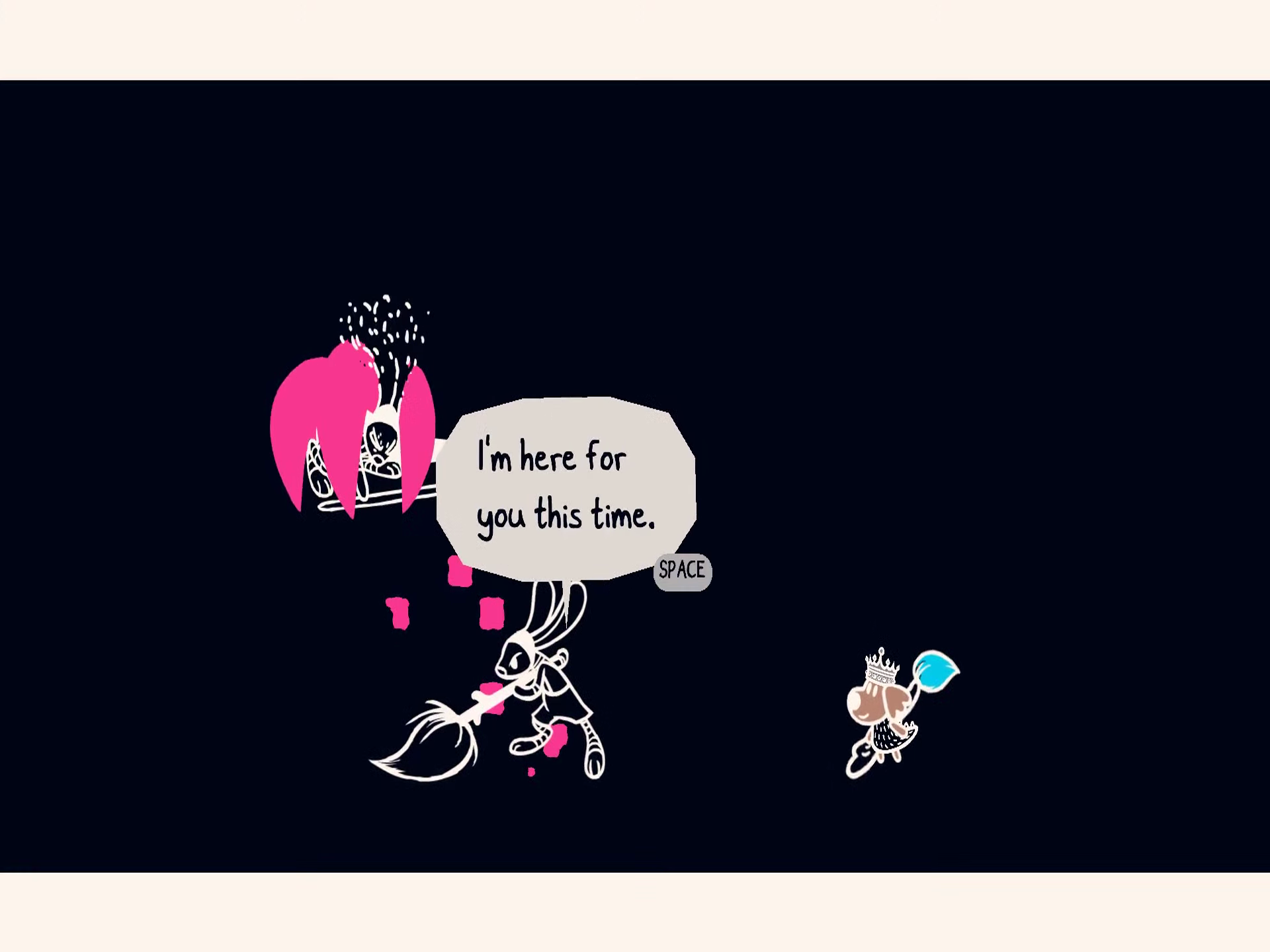
The rabbit has seen their dream come to light: a world where anyone can color, a world where the crushing legacy of Wielder is shattered because the title is meaningless. No Art School to pass, no brush mentor to please, no set of Wielder trials to overcome, no giant tower to set Wielders apart and above from the rest of Picnic. Nothing left to prove. A cozy apocalypse, perhaps.
Chicory made a brush herself. Finally, she found the fight within her to take a stand. Chicory, in the absolute last sequence of the game before credits, walks the walk rather than talks the talk. The sequence is cheezy, sure: you wait for Chicory to do her thing and then pile on the damage. The pair of you free each other from very scripted traps. However, the message rings true: you’re doing this, for the first time in A Colorful Tale, together. Chicory, it turns out, was worth fighting for.
As a final touch, this changes the game’s rapid “Continue?” sequence. I got choked up the first time it played, probably because I see myself in that rabbit. Normally you get the sfx and vfx of a tape rewinding, the audio-visual equivalent of “ahahaha nope, don’t worry that mistake didn’t just happen lololol.” That little rewind sound would play in my head every time I stumbled over a note in band, every “um...” in every public talk I’ve ever had to give. But now, Chicory steps into frame, and grabs your paw. She’s here to help, and together, you can rewrite history.

All screenshots of Chicory: A Colorful Tale were captured from the Gamer Zone Youtube Channel. They do Lets Plays, I guess?